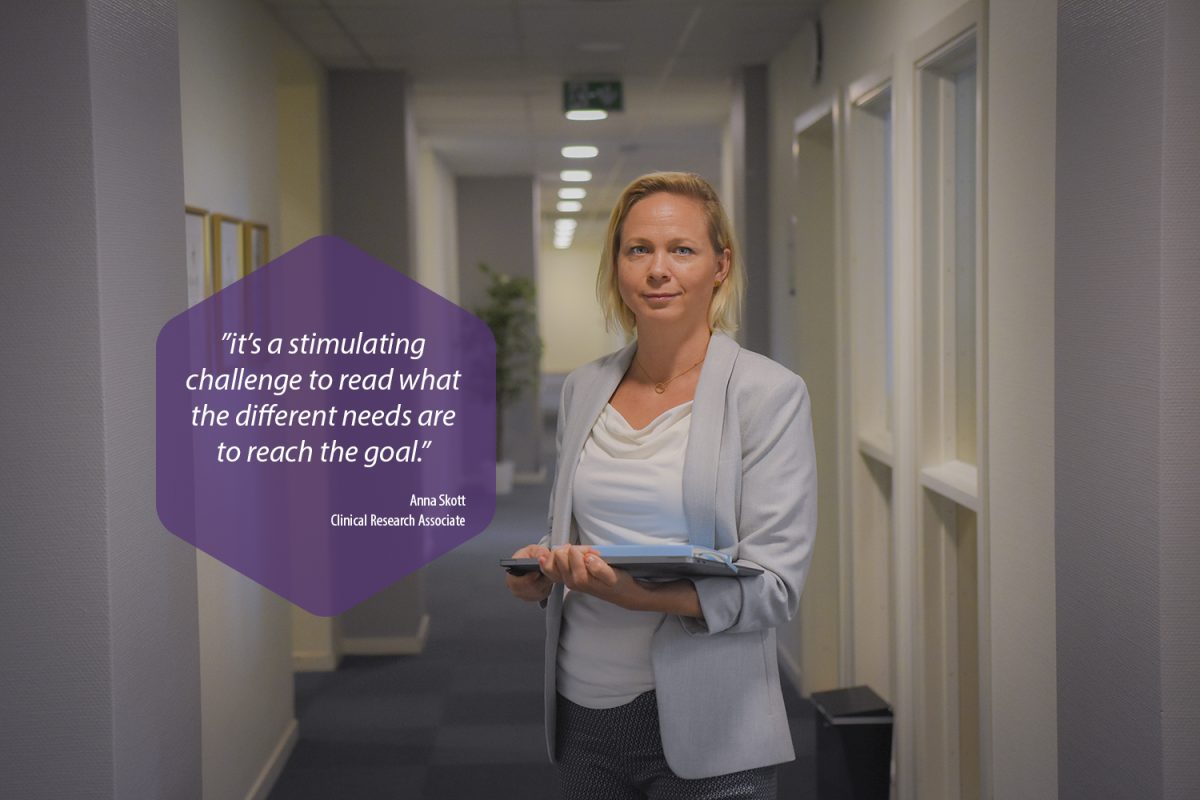
CTC-series: Meet our people. Part 7 – CRA, the important link between sponsor and clinic
Anna Skott, Team Leader Clinical Research Associate (CRA), has 12 years of experience in clinical trials. She holds a Master of Science in Pharmacy and has been working at Clinical Trial Consultants (CTC) for 5 years. Among other things, she is currently involved in starting up a medical device trial.
“CTC is a company with strong competence and broad experience within clinical trials in different phases and therapeutic areas, which is a tremendous asset when we meet different stakeholders’ needs and face challenges in our trials”, she says.
Anna Skott has solid knowledge and experience of both phase I and II trials. According to her, CTC excels in its flexibility, ability to recognise customer needs and to provide scientific, pharmacokinetic and medical advice at an early stage.
“Working with trials in different phases requires to some extent different thinking. For example, phase II trials require more logistics and administration as they often are conducted at multiple sites and sometimes even in several countries at the same time. In phase I, the clinical conduct is more challenging because there is not yet much information about the investigational product.“
As a CRA, Anna Skott has a quality controlling function and she is the primary contact between the clinic and sponsor. In her role, she ensures that the trial is conducted in accordance with current regulations, GCP and the protocol/investigational plan approved by the authorities. She monitors the work at the clinical research unit and follows up on possible deviations and safety events.
“Our most important assignment is to ensure that the subjects’ rights and safety are met and followed up correctly by the clinic.”
The CRAs at CTC also provide direct support to the clinics and can thus come up with timely advice. Anna Skott works both at the clinic and the office, she meets lots of people, holds trainings and monitors the quality of collected data. A CRA needs to know the local language and the national regulations.
“Medical records are always written in the local language and the regulations may differ between countries, although there are international regulations as well. For example, how to report Serious Adverse Events to the local authorities may differ between countries.”
In the CRA role, it is just as important to have a holistic perspective as having an eye for details. To be analytical, solution-oriented and pragmatic are other valuable qualities.
“The best thing about my role is the diversity. You need to have a sense of detail as well as social skills like building relationships and show interest in people. We meet many professionals, and it is a stimulating challenge to read what the different needs are to reach the goal.”
When monitoring, it is important to know what questions to ask and it comes with experience and developed processes, according to Anna Skott.
“One should ask what needs to be done when and what the risks are. The protocol or investigational plan is the framework and the more comprehensive and clear it is, the better we know what it takes to complete the trial and maintain a high quality.”
Risk-based monitoring involves building on potential risks in the trial, adapt the monitoring level to the needs and assess what is most important for the specific trial.
“This means that we focus on what actually makes a difference. In addition to the subjects’ rights and safety, it’s important to focus on data and processes that are related to the primary endpoint, that affects the trial outcome the most.”
One advantage CTC has is that both the clinical research units and monitoring are in-house, which increases efficiency because the CRA team is already familiar with the clinic’s processes. This makes the start-up timelines shorter. However, a common misunderstanding about having in-house monitoring is that it does not become independent.
“The CRAs and the clinic staff are organised in completely different lines within CTC, and we are also backed up by the Quality Assurance department. We report everything study-specific directly to the sponsor and we work according to predetermined processes and the risk-based monitoring plan approved by the sponsor. Systematic quality work and transparency are extremely important for our customers to feel completely confident with the work we perform.”
The CRAs also work close to the Biometrics department at CTC, which, among other things, delivers pre-programed data listings to detect possible deviations. If something needs to be investigated or verified with the clinic, it is the CRA that ensures it. Checks are also built directly into the electronic Case Report Form (eCRF) and the study team works according to a standardised centralised monitoring plan to review the quality of all clinics. It indicates if the sites work differently, for example with reporting of adverse events.
“We have regular meetings with pharmacokineticists, statisticians and programmers during the study to review the data. A standardised review of data is important to ensure quality.”
During the covid pandemic, Anna Skott and her team have noticed that remote monitoring (i.e. off-site monitoring) has become even more important than before due to limited possibility to visit the clinics.
“Since a lot of data is available electronically today, we have the opportunity to conduct many activities remotely, for example review data, draw conclusions, follow up and provide feedback to the clinic.”
Before each study starts, a Site Initiation Visit is performed to train study personnel and ensure that equipment, agreements and investigational products are in place. As subjects are enrolled, the CRA follows up on the clinic’s work, both on-site and remote. When the last subject has had their last visit, the database is locked and a close-out visit is performed. The CRA makes sure that all study documentation is in place in the local investigator site file and that equipment and any unused investigational product is properly disposed of. After each visit, reports and follow-up letters are written documenting what the CRA has monitored and what measures need to be taken.
“We have a comprehensive introductory program for CRAs that are new to their role. The program takes about six months and is carried out under the guidance of a more experienced CRA, who also continues to be a mentor. After completing the program, an internal CRA qualification certificate is issued,” says Anna Skott.
